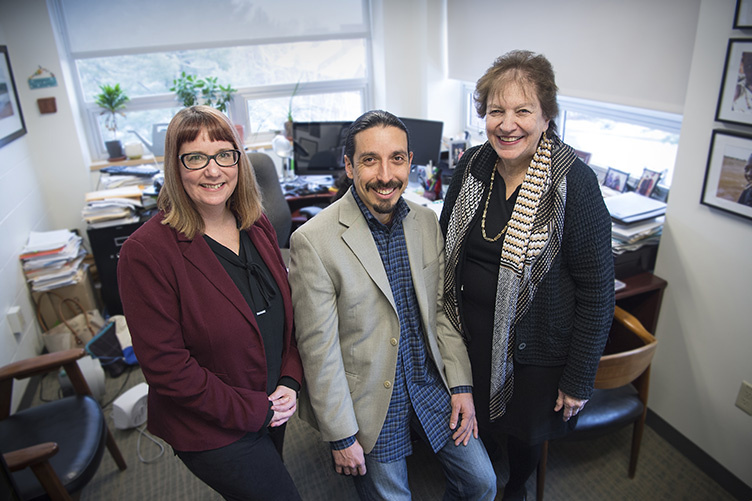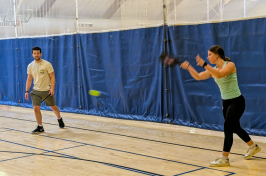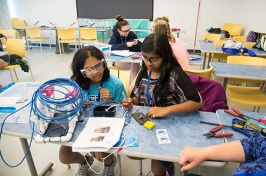
Professors Karen Van Gundy, Cesar Rebellon, and Ellen Cohn.
Why do some adolescents obey the rules, while others break them? Psychology professor Ellen Cohn and sociology professors Cesar Rebellon and Karen Van Gundy will now be able to build on more than a decade of research that seeks to answer this question. Thanks to a $373,000 National Science Foundation (NSF) grant, the researchers will expand upon data they have collected from more than 500 New Hampshire middle school students since 2006. This latest NSF grant will also allow them to study a third cohort of middle school students in order to make comparisons between groups and study differences between adolescent behaviors in 2006 vs. today.
Cohn says this is the third major National Science Foundation grant UNH has received that looks at rule-violating behavior among adolescents. In this study, the researchers will specifically look at the role of emotions and how they predict rule-breaking behavior. The previous NSF grant, awarded in 2010, examined legal socialization theory to help researchers better understand why some teenagers use drugs, bully their peers, act violently and/or steal. This grant built upon the first NSF grant in 2006 that looked at the role of personal attributes, attitudes and peer pressure in rule-violating behavior.
Ellen Cohn is a social psychologist who studies legal socialization, or how people develop attitudes toward the law and decide to engage in rule-violating behavior. She heads the Legal Socialization Lab at UNH, which focuses on testing and expanding legal socialization models.
“We are looking at ways in which emotions play a different role for females and males,” says Karen Van Gundy. “Guilt plays a different role in girls versus boys."
“At first we looked at legal attitudes and how they mediate between legal and moral reasoning, and specific rule-violating behaviors.” Cohn says. “In this new grant we will also be looking at kids and how they break or follow rules, but we will be focusing on the role of emotions such as shame and guilt.”
Cohn adds that the new grant will first examine how emotions change throughout adolescence and emerging adulthood, and then focus on how these emotions predict later rule-breaking behavior. Finally, researchers will compare the emotions, reasoning and attitudes of three distinct groups: students who never engaged in rule-breaking behavior during adolescence, students who engaged in rule breaking during adolescence and students who continue to break rules in emerging adulthood. Researchers plan to collect multiple data points at least twice a year over the grant period, including self-reported survey data.
“We are also looking at ways in which emotions play a different role for females and males,” says Van Gundy. “Guilt plays a different role in girls versus boys. We typically see in general that boys are more delinquent than girls — but that doesn’t hold for all rule-violating behaviors — their substance misuse is not that different. As they emerge into adulthood, that’s when the gap emerges,” with males engaging in substance misuse more than females.
Rebellon adds that the emotions of anger and the feeling of being treated unfairly by one’s family, peers, teachers and law enforcement play a role in rule-breaking behavior. The more adolescents feel like they are not being treated fairly, the more apt they are to engage in negative behaviors. Also, adolescents tend to engage in seemingly irrational behavior if it wins them popularity among their peers.
“Doing risky things may actually in a sense be very rational for them at that age, in so far as we see a positive relationship for males between risk seeking and popularity among peers,” he says.
Gaining a solid understanding of why adolescents break rules is helpful to parents, teachers and the law enforcement community, Cohn explains. It helps parents and community leaders working with adolescents develop the right interventions for students at the right time. In many cases, when teachers understand a child’s behavior and are able to intervene before a principal or school resource officer gets involved, they can extinguish poor behavior before that child is embroiled in the disciplinary process.
“Ultimately, the findings will provide important information for school-based intervention design and policies aimed at reducing behaviors like bullying and substance misuse by addressing both the cognitions and the emotions that promote or inhibit such behaviors,” she says.

-
Written By:
Krysten Godfrey Maddocks '96 | College of Liberal Arts | krysten.godfreymaddocks@unh.edu

















































